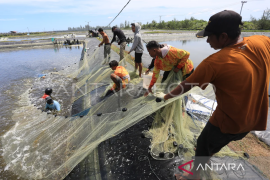The seaweed processing plants will soon be established in the districts of Muna and Wakatobi in an effort to step up regional revenue.
"Two large-scale seaweed processing plants will in the near future be established respectively in the districts of Muna and Wakatobi," Southeast Sulawesi Governor Nur Alam said in the provincial city of Kendari on Tuesday.
Nur Alam said he had asked all regional working units (SKPD) in the province to direct the people economic empowerment funds to the two districts where the seaweed processing plants would be established.
"The cooperatives and small and medium businesses (UKM) have the people economic empowerment funds of around Rp19 billion, and therefore I hope the funds will be directed to assist the development of seaweed cultivation in Wakatobi and Muna districts," Nur Alam said.
According to the governor, the local government would also fully support the development of seaweed cultivation in Wakatobi and Muna districts following the establishment of the two processing industries of the commodity there.
He added the existence of two seaweed processing plants in Wakatobi and Muna was expected to open a wider job opportunities for the people of the two districts in particular and those of South Sulawesi in general.
"In principle, the establishment of the two seaweed processing industries will open a wider job opportunity for the local people, and in turn it will improve the welfare of Southeast Sulawesi people as a whole," the governor said.
Meanwhile, Wakatobi District Development Planning Agency spokesman Abdul Manan said the establishment of seaweed processing industries in the districts of Muna and Wakatobi would directly be handled by seven ministries in the United Indonesia Cabinet phase 2 through the local economic development program.
According to Abdul Manan, the seven ministries were among others Ministry for Cooperatives and Small and Medium Enterprises (UKM), State Enterprises Ministry (BUMN), Maritime Affairs and Fisheries Ministry, Trade Ministry, Industry Ministry, and State Ministry for Disadvantaged Regions.
He said the seven ministries would also help the local people manage the seaweed seedling, cultivation, and post-harvest handling to meet the demand of the two processing industries.
Abdul Manan added that in Wakatobi alone the seaweed potential was big enough and could reach hundreds of tons per year for the local economic development.
"Wakatobi coastal area has a total of 4,721 hectares which are very potential for seaweed cultivation but unfortunately only around 734 hectares have been used so far," Abdul Manan said.
Southeast Sulawesi maritime and fisheries office spokesman Abdul Salam has ever said in Kendari that seaweed commodity in the province was in abundance and therefore many domestic and foreign investors had expressed their eagerness to invest.
"But unfortunately the prices of the seaweed commodity in the province are unstable because many middlemen intentionally want to damage the prices," he said.
Therefore he added that the abundant commodity should be processed into half done material through a processing industry.
He said the province has very strategic waters for seaweed cultivation and its potential is promising for the development of the seaweed industry.
According to him, investment of seaweed in Southeast Sulawesi should be promoted by the government and the farmers.
Through the maritime affairs and fisheries ministry, Indonesia is working out an ambitious plan to make itself a world seaweed production center in the coming five years.
To achieve this goal, the government is planning to create 60 seaweed cultivation clusters, restrict and then stop dried seaweed exports and build local seaweed processing industries, although they have yet to be developed optimally.
So far, only about 15 percent of Indonesia`s seaweed exports are in the form of processed products while the remaining 85 percent are in the form of dried seaweed.
In order to increase supply for domestic seaweed processing industries, a seaweed cluster development scheme was launched in various parts of the country.
The efforts to cultivate seaweed cluster schemes are being made to integrate upstream and downstream processing so that production can become optimal and have added value.
In Southeast Sulawesi the seaweed farming is a predominant activity, largely because of the accessibility of protected inshore waters and the ideal ambient environmental conditions.
The commonly cultured seaweed is Kappaphycus cottoni (formerly Eucheuma).
Unlike grouper and lobster farming, seaweed farming is typically a family activity, with all adults of the household being involved in one way or the other.
The seaweed farming in the province is conducted in community-based clusters with each consisting of 10 to 15 families.
Although seaweed farming is currently profitable, it is also a farming system that is very environmentally friendly as it is carbon sequestering.
Meanwhile, seaweed product in South Sulawesi province this year is targeted to reach 880,000 tons.
South Sulawesi provincial administration spokesman for economic affairs Amal Natsir said in Makassar on Wednesday that the province mainstay commodity had a bigger overseas market opportunity following a food diversification program in a number of target countries.(*)
Reporter: Otniel Tamindael
Editor: Jafar M Sidik
Copyright © ANTARA 2011











